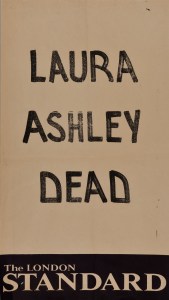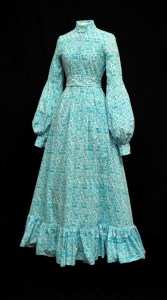I recently acquired a newsstand poster issued by The London Standard in 1985 announcing the death of Laura Ashley. It was found amongst a stack of other stuff: posters from Biba and Fiorucci; a Mr Freedom shopper; Indica wrapping paper by Paul McCartney et al from London’s art/design/shopping scenes of the late 1960s to the 1980s. ‘Laura Ashley is Dead’ was much in my mind when, as a guest of bamboo collector Greville Worthington, I attended the joint opening night of ‘Laura Ashley, The Romantic Heroine’ and ‘Henry Poole & Co. Founder of Savile Row: The Art of Bespoke Tailoring and Wool Cloth’ at Bowes Museum.

Newsstand poster announcing the death of Laura Ashley (1985)
Poole and Ashley are strange bedfellows: two very different family firms with divergent approaches to dressing and business. Poole is the epitome of the Savile Row Court tailor and very firmly of the old school, ‘The Establishment’. The other is much more rooted in the egalitarian middle class post-war world. One is of the private fitting room and discreet shop, the other of the high street. Both were, in a strange sense, concerned with comportment and dress code, though with a very different raison d’être.
Poole & Co.’s origins are in military tailoring, business, hunting, formal and ceremonial dress, so they were about tradition, craft, service, historical continuity and Empire. In the textile rooms at Bowes, the Royal Warrants were lined up along one wall and they included (much to my enjoyment) a red, gold and green one from Emperor Haile Selassie I, Lion of Judah. Poole projects a ‘golden age’ of hierarchy and rank where everyone knew their place; an age of certainty and world power, when a man could be judged by the cut of his cloth and the shoes he wore.
Laura Ashley was arguably a demure response to the micro mini-skirts of the 1960s: more wearable maxis and long flowery dresses. So, it was in effect a moral retreat into comportment and romantic femininity, an invented tradition, with a goddess cult at its heart. This was a form of heroine-worship for an imagined golden age when woman were courted, adored and respected, and ‘loved’.

Laura Ashley Bowes bequest Bowes Museum
You can see this transition from above the knee to below very easily, when, as at Bowes, the dresses are lined up chronologically. In her book The Sixties: Decade of Design Revolution, Lesley Jackson sees both late Biba and early Ashley as coming out of a type of ‘historical revivalism’ such as Art Nouveau and Victorianism that later – when others jumped on the bandwagon – became a formulaic substitution for innovation and creativity; Google’s ‘Flake chocolate adverts’ for example.
Laura and Bernard Ashley’s first wave of revivalism came as a fresh take on Liberty in their wallpaper designs of the 1950s; then developed into a successful workshop; a retail outlet in London in 1969 and ultimately a worldwide chain of shops with a range of designs covering every inch of the modern ‘old-fashioned’ home. Jackson points out how this commercial success story emerged from a very original 1960s idea of taking a fresh look at the past. This, in Ashley’s case, was copied so widely that ‘by the end of the 1970s, historical revivalism had swamped modern design completely’.
This was nothing new of course for the history of textiles: in The Invention of Tradition: The Highland Tradition of Scotland Hugh Trevor-Roper wrote of how the bagpipe-playing, tartan-wearing Scotsman of ‘great antiquity, is in fact largely modern’. In the same sense, Laura Ashley is not dead, and she lives on in next season’s rediscovery of her.
‘Laura Ashley: The Romantic Heroine’ is on at the Bowes Museum until 5 January 2014.

Revival: Laura Ashley
Long-sleeved long dresses in Laura Ashley prints (1970s) © Laura Ashley Ltd
Share
I recently acquired a newsstand poster issued by The London Standard in 1985 announcing the death of Laura Ashley. It was found amongst a stack of other stuff: posters from Biba and Fiorucci; a Mr Freedom shopper; Indica wrapping paper by Paul McCartney et al from London’s art/design/shopping scenes of the late 1960s to the 1980s. ‘Laura Ashley is Dead’ was much in my mind when, as a guest of bamboo collector Greville Worthington, I attended the joint opening night of ‘Laura Ashley, The Romantic Heroine’ and ‘Henry Poole & Co. Founder of Savile Row: The Art of Bespoke Tailoring and Wool Cloth’ at Bowes Museum.
Newsstand poster announcing the death of Laura Ashley (1985)
Poole and Ashley are strange bedfellows: two very different family firms with divergent approaches to dressing and business. Poole is the epitome of the Savile Row Court tailor and very firmly of the old school, ‘The Establishment’. The other is much more rooted in the egalitarian middle class post-war world. One is of the private fitting room and discreet shop, the other of the high street. Both were, in a strange sense, concerned with comportment and dress code, though with a very different raison d’être.
Poole & Co.’s origins are in military tailoring, business, hunting, formal and ceremonial dress, so they were about tradition, craft, service, historical continuity and Empire. In the textile rooms at Bowes, the Royal Warrants were lined up along one wall and they included (much to my enjoyment) a red, gold and green one from Emperor Haile Selassie I, Lion of Judah. Poole projects a ‘golden age’ of hierarchy and rank where everyone knew their place; an age of certainty and world power, when a man could be judged by the cut of his cloth and the shoes he wore.
Laura Ashley was arguably a demure response to the micro mini-skirts of the 1960s: more wearable maxis and long flowery dresses. So, it was in effect a moral retreat into comportment and romantic femininity, an invented tradition, with a goddess cult at its heart. This was a form of heroine-worship for an imagined golden age when woman were courted, adored and respected, and ‘loved’.
Laura Ashley Bowes bequest Bowes Museum
You can see this transition from above the knee to below very easily, when, as at Bowes, the dresses are lined up chronologically. In her book The Sixties: Decade of Design Revolution, Lesley Jackson sees both late Biba and early Ashley as coming out of a type of ‘historical revivalism’ such as Art Nouveau and Victorianism that later – when others jumped on the bandwagon – became a formulaic substitution for innovation and creativity; Google’s ‘Flake chocolate adverts’ for example.
Laura and Bernard Ashley’s first wave of revivalism came as a fresh take on Liberty in their wallpaper designs of the 1950s; then developed into a successful workshop; a retail outlet in London in 1969 and ultimately a worldwide chain of shops with a range of designs covering every inch of the modern ‘old-fashioned’ home. Jackson points out how this commercial success story emerged from a very original 1960s idea of taking a fresh look at the past. This, in Ashley’s case, was copied so widely that ‘by the end of the 1970s, historical revivalism had swamped modern design completely’.
This was nothing new of course for the history of textiles: in The Invention of Tradition: The Highland Tradition of Scotland Hugh Trevor-Roper wrote of how the bagpipe-playing, tartan-wearing Scotsman of ‘great antiquity, is in fact largely modern’. In the same sense, Laura Ashley is not dead, and she lives on in next season’s rediscovery of her.
‘Laura Ashley: The Romantic Heroine’ is on at the Bowes Museum until 5 January 2014.
Unlimited access from just $16 every 3 months
Subscribe to get unlimited and exclusive access to the top art stories, interviews and exhibition reviews.
Share
Recommended for you
Small Wonders: The Grundy Art Gallery
Richard Parry, curator of the Grundy Art Gallery, talks to Apollo about the Blackpool gallery’s collection
Ideal Man
The Musée d’Orsay’s exhibition of male nudes is almost a great show, but it misses a timely opportunity to explore homoerotic sentiment in art
Book Competition
This month’s book competition offers you the chance to win the ‘Masterpieces: Art and East Anglia’ exhibition catalogue, edited by Ian Collins